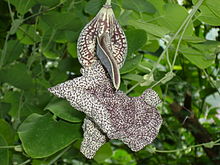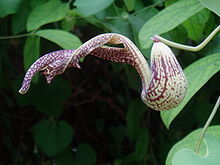
Aristolochic acids are a family of carcinogenic, mutagenic, and nephrotoxic phytochemicals commonly found in the flowering plant family Aristolochiaceae (birthworts). Aristolochic acid (AA) I is the most abundant one. The family Aristolochiaceae includes the genera Aristolochia and Asarum, which are commonly used in Chinese herbal medicine. Although these compounds are widely associated with kidney problems, liver and urothelial cancers, the use of AA-containing plants for medicinal purposes has a long history. The FDA has issued warnings regarding consumption of AA-containing supplements.

Asarum is a genus of plants in the birthwort family Aristolochiaceae, commonly known as wild ginger.
Dutchman's pipe is a common name for some unrelated flowering plants, which have flowers, inflorescences or stems resembling a pipe:

Aristolochia californica, the California pipevine, California Dutchman's-pipe, or California snakeroot is a perennial woody vine of western North America.

Battus philenor, the pipevine swallowtail or blue swallowtail, is a swallowtail butterfly found in North America and Central America. This butterfly is black with iridescent-blue hindwings. They are found in many different habitats, but are most commonly found in forests. Caterpillars are often black or red, and feed on compatible plants of the genus Aristolochia. They are known for sequestering acids from the plants they feed on in order to defend themselves from predators by being poisonous when consumed. The adults feed on the nectar of a variety of flowers. Some species of Aristolochia are toxic to the larvae, typically tropical varieties. While enthusiasts have led citizen efforts to conserve pipevine swallowtails in their neighborhoods on the West coast, the butterfly has not been the subject of a formal program in conservation or protected in legislation. The butterfly is however of "Special Concern" in Michigan, which is on the Northern limit of its range.

Balkan endemic nephropathy (BEN) is a form of interstitial nephritis causing kidney failure. It was first identified in the 1920s among several small, discrete communities along the Danube River and its major tributaries, in the modern countries of Croatia, Bosnia and Herzegovina, Serbia, Kosovo, Romania, and Bulgaria. It is caused by small long-term doses of aristolochic acid in the diet. The disease primarily affects people 30 to 60 years of age. Doses of the toxin are usually low and people moving to endemic areas typically develop the condition only when they have lived there for 10–20 years. People taking higher doses of aristolochic acid have developed kidney failure after shorter durations of exposure.
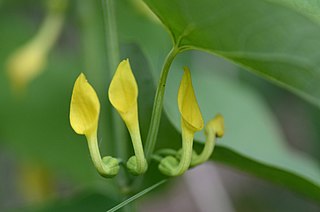
Aristolochia clematitis, the (European) birthwort, is a twining herbaceous plant in the family Aristolochiaceae, which is native to Europe. The leaves are heart shaped and the flowers are pale yellow and tubular in form. The plant seeks light by ascending the stems of surrounding plants.
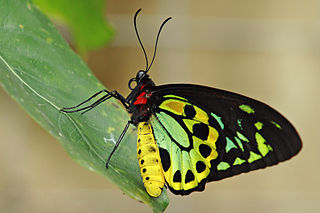
Ornithoptera euphorion, the Cairns birdwing, is a species of birdwing butterfly endemic to Queensland, and is Australia's largest endemic butterfly species. Other common names include Cooktown birdwing and northern birdwing. The names Cairns and Cooktown in its common name reference the Australian cities in the region where this butterfly is found.

Aristolochia gigantea, the Brazilian Dutchman's pipe or giant pelican flower, is an ornamental plant native to Brazil. Typical of subtropical Bahia and Minas Gerais vegetation, it is a vigorous evergreen climber (vine) with heart-shaped leaves and spectacular fragrant flowers. This plant is cited in Flora Brasiliensis by Carl Friedrich Philipp von Martius. A. gigantea and other tropical Dutchman's pipe varieties pose a threat to the pipevine swallowtail butterfly. The butterfly confuses A. gigantea with its native host plant and will lay eggs on it although pipevine swallowtail caterpillars cannot survive on the foliage.

Aristolochia tagala is commonly known as Indian birthwort and locally as Dutchman's pipe.
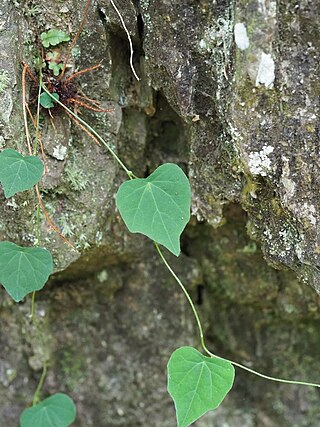
Stephania tetrandra is a herbaceous perennial vine of the family Menispermaceae native to China and Taiwan. It grows from a short, woody caudex, climbing to a height of around three meters. The leaves are arranged spirally on the stem, and are peltate, i.e. with the leaf petiole attached near the centre of the leaf. Its root is used in traditional Chinese medicine (TCM).

Aristolochia grandiflora, the pelican flower, is a deciduous vine with one of the world's largest flowers that emits an odor that smells like rotting meat, attracting flies.

Aristolochia indica is a creeper plant found in Southern India and also Sri Lanka. It Is known as 'sapsada' in Sri Lanka and is critical to the survival of the southern birdwing and common birdwing, as well as crimson and common rose butterflies. It reaches a height of several metres on trees and cover the branches with thick foliage. It is commonly found in forest floor, rocky hillslopes. It flowers once a year to produce seeds. It can also be propagated by roots. The plant has a number of historical medicinal uses.

Aristolochia longa or long aristolochia is a species of pipevine.
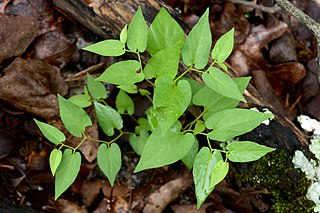
Aristolochia serpentaria is a species of perennial flowering plant in the Aristolochiaceae (birthwort) family. The species is commonly known as Virginia snakeroot and is native to eastern North America, from Connecticut to southern Michigan and south to Texas and Florida.

Battus philenor hirsuta, the California pipevine swallowtail or hairy pipevine swallowtail, is a subspecies of the pipevine swallowtail that is endemic to Northern California in the United States. The butterfly is black with hindwings that have iridescent green-blue coloring above and a row of red spots below; the caterpillars are black with fleshy protrusions and orange spots. This subspecies is smaller in size, hairier, and lays eggs in larger clutch sizes than the nominate subspecies. The egg clutches are deposited on the shoot tips of the California pipevine, a perennial vine native to riparian, chaparral, and woodland ecosystems of the California Coast Ranges, Sacramento Valley, and Sierra Nevada foothills. The larvae feed exclusively on the foliage and shoot tips of the pipevine, although adults eat floral nectar from a variety of plants. The plant contains a toxic substance, aristolochic acid. The larvae sequester the toxin, and both the juvenile and adult butterflies have high and toxic concentrations of the aristolochic acid in their tissues. Throughout the range of the species, Battus philenor, other butterflies and moths mimic the distinctive coloration of the swallowtail to avoid predators. However, there are no known mimics of the Californian subspecies.
Aristolochia watsonii is a perennial plant in the birthwort family (Aristolochiaceae), found growing among plants of the Arizona Uplands in the Sonoran Desert. The plant is inconspicuous, small and hard to spot, but can be found by following the pipevine swallowtail which lays eggs on it.
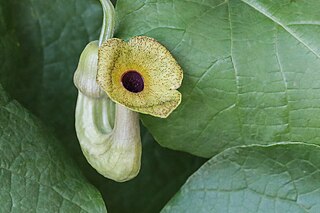
Aristolochia macrophylla, Dutchman's pipe or pipevine, is a perennial vine native to the eastern United States. A. macrophylla belongs to the plant family Aristolochiaceae and is found primarily along the Cumberland Mountains and Blue Ridge Mountains in the eastern portion of the United States, as well as Ontario, Canada. This species of plant has received considerable attention in the past few decades for the discovery of a potent compound called aristolochic acid, which has been the focus of debate due its harmful side effects.
Aristolochia fangchi, is a species of flowering plant in the family Aristolochiaceae, native to Vietnam and southeast and south-central China.
